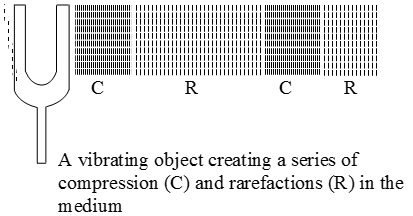What is Sound and How is it Produced
- Sound is a form of energy that produces the sensation of hearing in our ears.
Frequency range of audible sound for human is between 20Hz to 20 KHz - Sound need Material to Travel: You have learnt in previous section that vibrations produce sound. To produce vibrations, we need a material body. Therefore, we can say that a medium is needed for sound to travel. Sound can travel through air (or gases), liquids and solids, but not through vacuum.
- The Time Gap between ‘Seeing’ and ‘Hearing’ is due to the difference between the time taken by the light and the sound to travel from the source to the observer.
- The speed of light high 3 × 108 meters per second (30 crore metres per second) and the speed of sound in the air under normal conditions is 344 metres per second. So, the light travels almost instantaneously, whereas sound takes some time.
- Sound Wave are Longitudinal Waves: Sound travels through air in the form of longitudinal waves.
People also ask
- What are the Different Types of Sound?
- Analysing Sound Waves
- What are the Characteristics of Sound Waves?
- What is Echo and Sonar?
How Sound is Produced by Humans?
Have you ever placed your palm on the speaker of a cassette player when it was playing or touched your throat while speaking? What did you feel? You will feel a vibration. A vibration can be defined as a rapid back and forth movement of a body about a central position. A sound is produced because of a vibration. Thus, sound is a vibration that is capable of being heard. The organ in human beings that is involved in the production of sound is the larynx (commonly called the voice box). The voice box is situated in the neck at the upper end of the wind pipe. The sound produced is controlled by vocal cords, which are thin membranes stretched across the voice box. There are muscles attached to the vocal cords. These muscles can vary the tension in the vocal cords (i.e., make them tight or loose). With the help of these muscles, we can make different sounds.

Activity
Aim: To demonstrate that sound is produced by vibration.
Materials needed: A cassette player/television.
Method:
1. Hold your throat with your finger tips. Now speak or sing for about 5-10 seconds. What do you feel?
2. Turn on the cassette player/television. Place your palm on its speaker. What do you feel?
Observation: In the first case, you should be able to feel the vibrations in your throat. In the second case, you should be able to feel the vibrations in the speaker.
Conclusion: Sound is produced by vibration.
Production & Propagation Of Sound
Production of sound
Sound is produced when an object vibrates (moves back and forth rapidly). In other word, sound is produced by vibrations of objects.
Propagation of sound
When an object vibrates (and makes sound), then the air layers around it also start vibrating in exactly in the same way and carry sound waves from the sound producing object to our ears. Transmission of sound requires a material medium so it cannot travel through vacuum.
In laboratory a vibrating tuning fork is used for producing sound. During vibration, the prong of the tuning fork moves from one extreme position to another about its mean position (the position when it is at rest).
Let us now see what happens in the air near a vibrating prong of a tuning fork.

SOUND AS A LONGITUDINAL WAVE
When a sound wave travels through the air, the molecules in the air oscillate to and fro about their mean positions in the direction of propagation of the sound wave. Therefore, Sound waves are called longitudinal waves.
The sound waves propagate in any material medium as a series of compressions or rarefactions.
SOUND WAVE CAN BE STUDIED IN TERMS OF PRESSURE AND DENSITY WITH DISTANCE AND TIME
Pressure & density is high for the particle whose amplitude is less, i.e. at compression state.